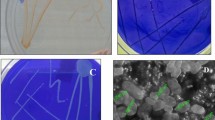Abstract
Main objective of present work was to isolate polyhydroxyalkanoate (PHA) from cell lysate of Bacillus flexus by aqueous-aqueous two-phase system (ATPS). Selected ATPS having polyethylene glycol (12%, w/v) and potassium phosphate (9.7%, pH 8.0) containing cell lysate obtained by sonication or hypochlorite treatment of B. flexus biomass (1 g%, dry weight), was held at 28°C for 30 min, which partitioned PHA into top PEG phase and residual cell materials into bottom phase. For enzymatic cell hydrolysis, Microbispora sp. culture filtrate having protease (3 U/mL) was mixed with B. flexus biomass and ATPS, incubated at 37°C for 2 h prior to phase separation. PHA recovered by centrifugation was 19∼51% of cell dry weight, depending on the mode of cell disruption. Protease was recovered along with PHA in the PEG phase and showed 7 fold increase in activity. PHA was characterized by GC, FTIR, and 1H NMR. Results indicated that ATPS can be used for the isolation of PHA from hydrolyzed bacterial cells and purified protease can be recovered as a byproduct, in a single defined experiment. Results have indicated that ATPS can be successfully employed as a non-organic solvent method for the isolation of PHA.
Similar content being viewed by others
References
Byrom, D. (1987) Polymer synthesis by microorganisms: Technology and economics. Trends in Biotechnol. 5: 246–250.
Lee, S. Y. (1996) Bacterial polyhydroxyalkanoate. Biotechnol. Bioeng. 49: 1–10.
Holmes, P. A. and G. B. Lim (1990) Separation process. US Patent 4,910,145.
Kshama, L. and T. R. Shamala (2006) Extraction of polyhydroxyalkanoate from Sinorhizobium meliloti cells using Microbispora sp culture and its enzymes. Enzyme Microbial Technol. 39: 1471–1475.
Mayerhoff, Z. D. V. L., I. C. Roberto, and T. T. Franco (2004) Purification of xylose reductase from Candida mogii in aqueous two-phase systems. Biochem. Eng. J. 18: 217–223.
Rabelo, A. P. B., E. B. Tanbiygu, and A. Pessoa (2004) Bromelain partiotioning in two-phase aqueous system containing PEO-PPO-PEO block copolymers. J. Chromatogr. B 807: 61–68.
Bensch, M., B. Selbach, and J. Hubbuch (2007) High throughput screening techniques in downstream processing: preparation, characterization, and optimization of aqueous two-phase systems. Chem. Eng. Sci. 62: 2011–2021.
Porto, T. S., G. M. Medeiros de Silva, C. S. Porto, M. T. H. Cavalcanti, B. B. Neto, J. L. Lima-Filho, A. Converti, A. L. F. Porto, and A. Pessoa (2007) Liquid-liquid extraction of proteases from fermented broth by PEG/citrate aqueous two-phase system. Chem. Eng. Process. 47: 716–721.
Shibusawa, Y., N. Takeuchi, K. Tsutsumi, N. Shigeru, A. Yanagida, H. Shindo, and Y. Ito (2007) One-step purification of histone deacetylase from Escherichia coli celllysate by counter-current chromatography using aqueous two-phase system. J. Chromatogr. A 1151: 158–163.
Narayan, A. V., M. C. Madhusudhan, and K. S. M. S. Raghavarao (2008) Extraction and purification of Ipomoea peroxidase employing three-phase partitioning. Appl. Biochem. Biotechnol. DOI/10.1007/S.12010-008-8185-4.
Kshama L, N. K. Rastogi, and T. R. Shamala (2004) Simultaneous and comparative assessment of parent and mutant strain of Rhizobium meliloti for nutrient limitation and enhanced polyhydroxyalkanoate (PHA) production using optimization studies. Process Biochem. 39: 1977–1983.
Law, J. H. and R. A. Slepecky (1996) Assay of polyhydroxybutyric acid. J. Bacteriol. 82: 33–36.
Hofsten, B. V. and G. D. Baird (1962) Fractionation of cell constituents of Bacillus megaterium in a polymer two-phase system. Biotechnol. Bioeng. 4: 403–410.
Raghavarao, K. S. M. S., N. K. Rastogi, M. K. Gowthaman, and N. G. K. Karanth (1995) Aqueous twophase extraction for down stream processing of enzymes/proteins. Advs. Appl. Microbiol. 41: 97–171.
Zaslavasky, B. Y. (1995) Aqueous two phase partitioning: Physical chemistry and bioanalytical application. pp. 663. Marcel Decker, New York, USA.
Brandl, H., R. A. Gross, R. W. Lenz, and R. C. Fuller (1988) Pseudomonas oleovorans as a source of poly (hydroxyalkanoate) for potential application as biodegradable polyesters. Appl. Environ. Microbiol. 54: 1977–1982.
Barham, P. J., A. Keller, E. L. Otun, and P. A. Holmes (1984) Crystallization and morphology of a bacterial thermoplastic: Poly-3-hydroxybutyrate. J. Mat. Sci. 19: 2781–2794.
Lowry, O. H., N. J. Rosenborough, A. L. Farr, and R. J. Randall (1951) Protein measurement with the folin phenol reagent. J. Biol. Chem. 193: 265–275.
Greenberg, D. M. (1995) Plant proteolytic enzymes: Methods in enzymology. pp. 54–64. Academic press, New York, USA.
Choi, J. and S. Y. Lee (1997) Process analysis and economic evaluation of poly (3-hydroxybutyrate) production by fermentation. Bioprocess and Biosys. Eng. 17: 335–342.
Brandl, H., R. A. Gross, R. W. Lenz, and R. C. Fuller (1990) Plastics from bacteria and for bacteria: poly(β-hydroxyalkanoates) as natural, biocompatible, and biodegradable polyesters. Adv. Biochem. Eng. Biotech. 41: 77–93.
Choi, J. and S. Y. Lee (1999) Efficient and economical recovery of poly (3-hydroxybutyrate) from recombinant Escherichia coli by simple digestion with chemicals. Biotechnol. Bioeng. 62: 546–553.
Chen, G. Q., G. Zhang, S. J. Park, and S. Y. Lee (2001) Industrial scale production of poly (3-hydroxybutyrate co-hydroxyhexanoate). Appl. Microbiol. Biotechnol. 57: 50–55.
Hachem, F., B. A. Andrews, and J. A. Asenjo (1996) Hydrophobic partitioning of proteins in aqueous two phase systems. Enzyme Microbial. Technol. 19: 507–517.
Ravindra Babu, B., N. K. Rastogi, and K. S. M. S. Raghavarao (2008) Liquid-liquid extraction of brome lain and polyphenol oxidase using aqueous two-phase system. Chemical Eng. Processing 47: 83–89.
Pancera, S. M., L. H. M. Silva, W. Loh, R. Itri, A. Pessoa, and D. F. S. Petri (2002) The effect of poly(ethylene glycol) on the activity and structure of glucose-6-phosphate dehydrogenase in solution. Colloid. Surf. B 26: 291–300.
Author information
Authors and Affiliations
Corresponding author
Rights and permissions
About this article
Cite this article
Divyashree, M.S., Shamala, T.R. & Rastogi, N.K. Isolation of polyhydroxyalkanoate from hydrolyzed cells of Bacillus flexus using aqueous two-phase system containing polyethylene glycol and phosphate. Biotechnol Bioproc E 14, 482–489 (2009). https://doi.org/10.1007/s12257-008-0119-z
Received:
Accepted:
Published:
Issue Date:
DOI: https://doi.org/10.1007/s12257-008-0119-z




